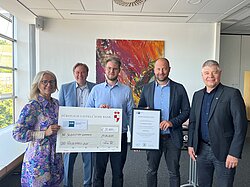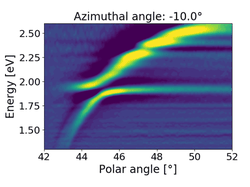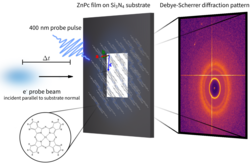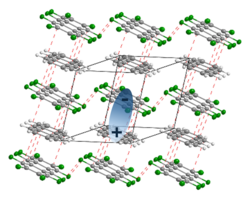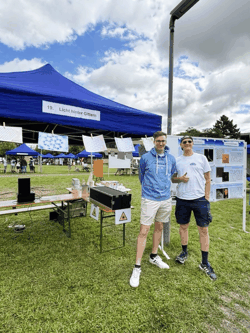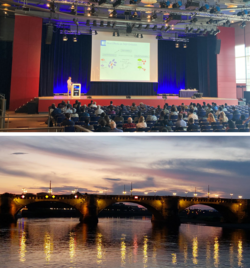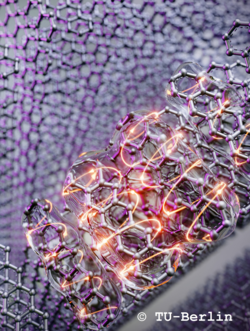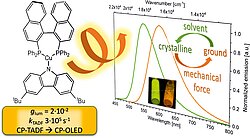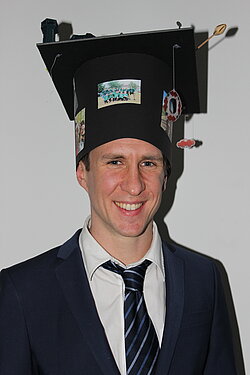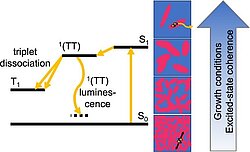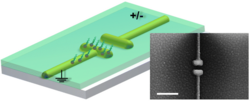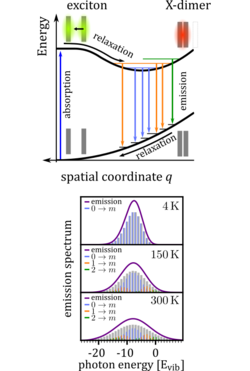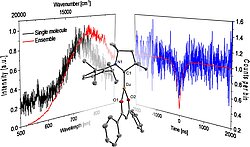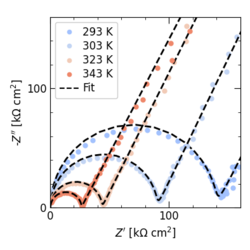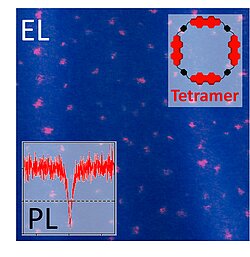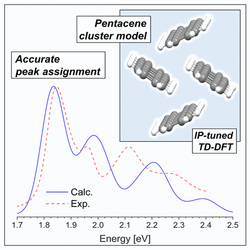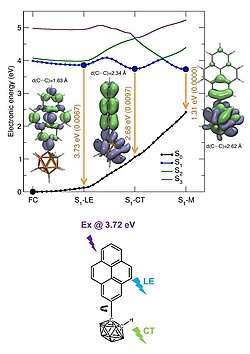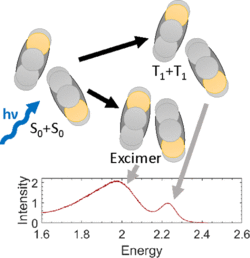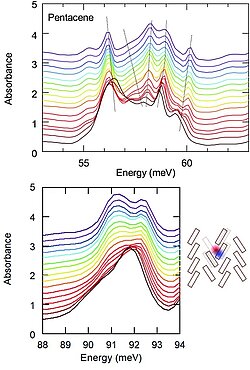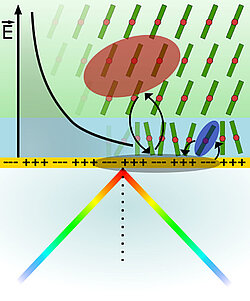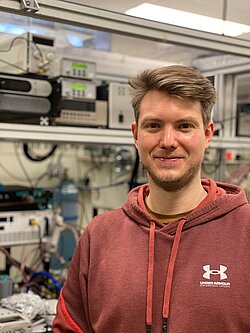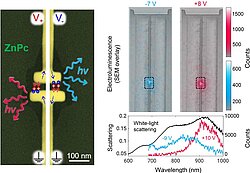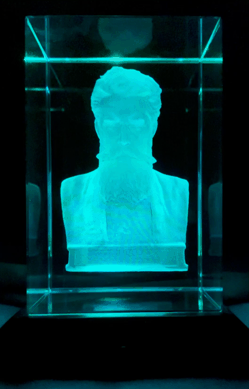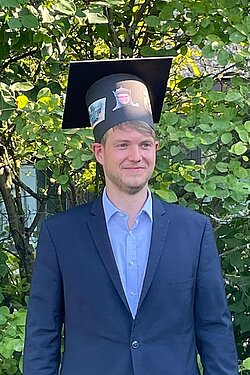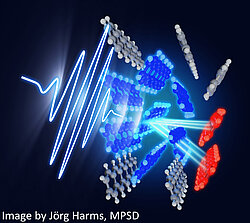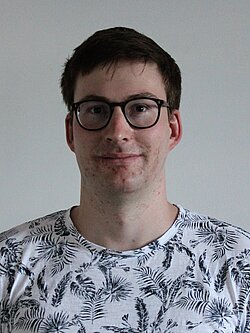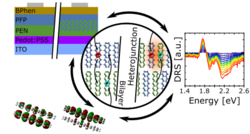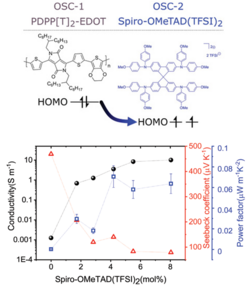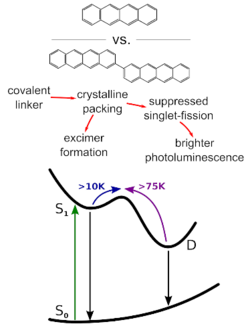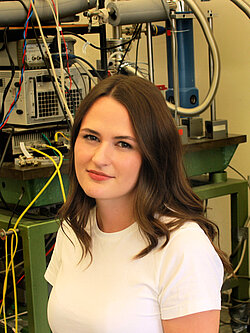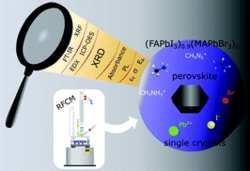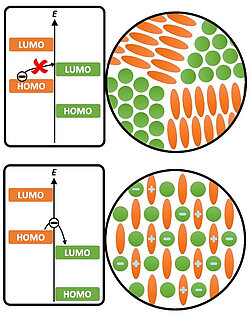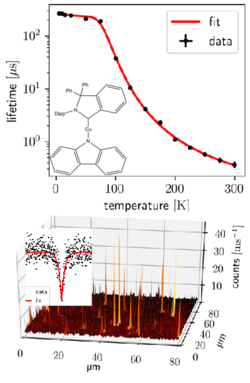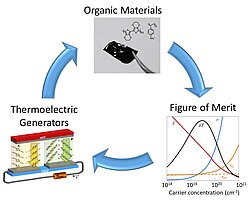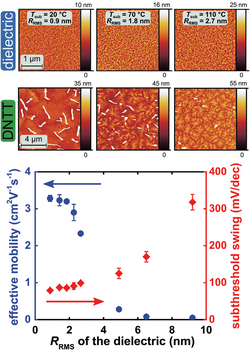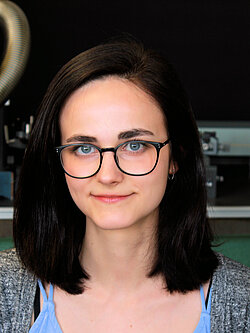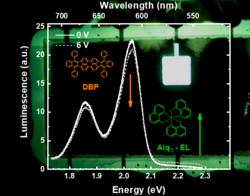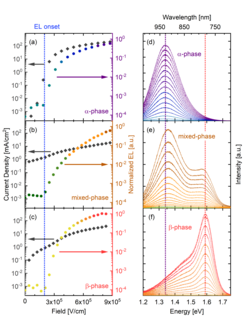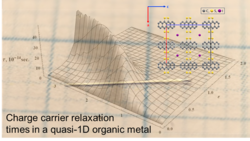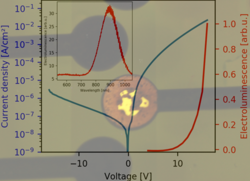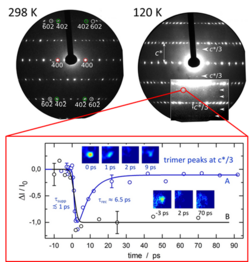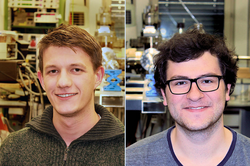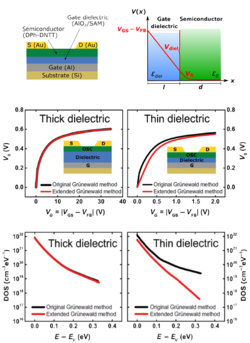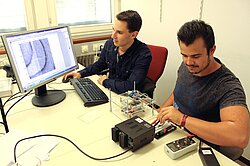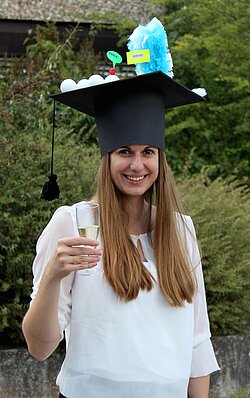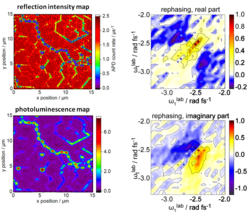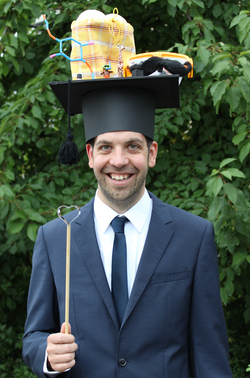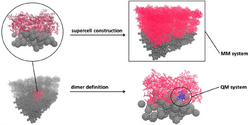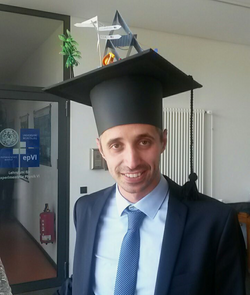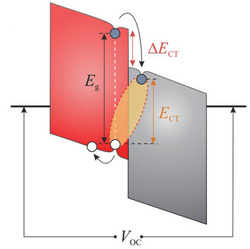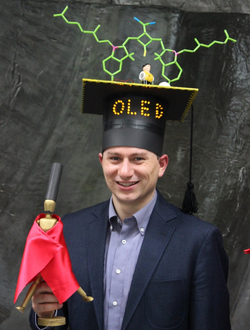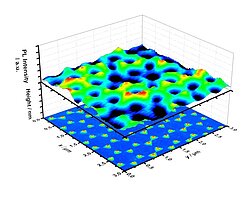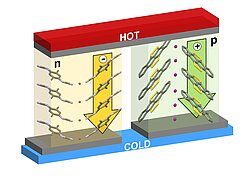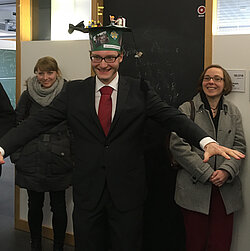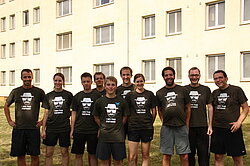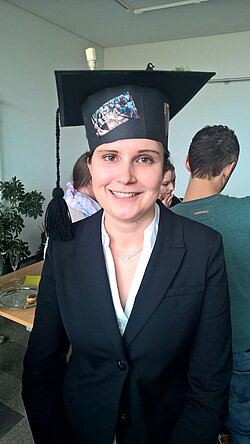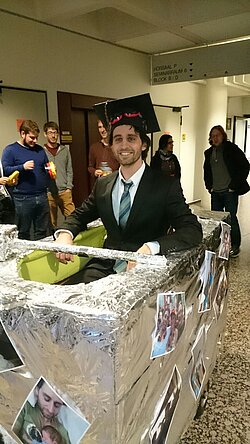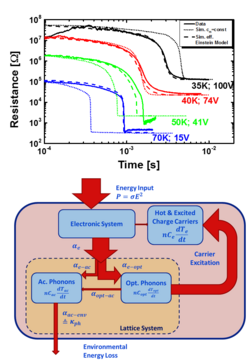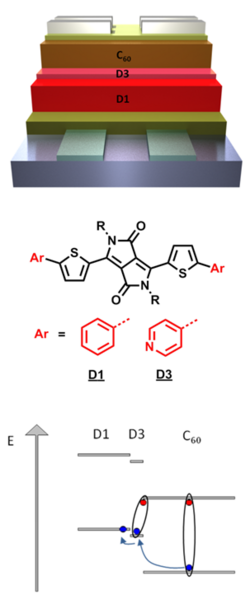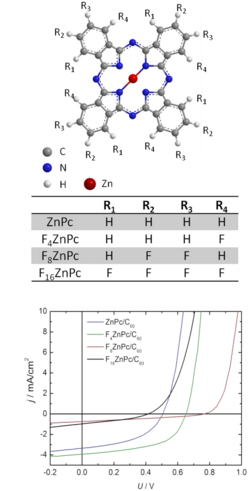News
29.04.2025
We are excited to announce that Sebastian Hammer received the prestigious "Univeristäts-Förderpreis" (university sponsorship award) of the IHK. Sebastian receives 25 000 € funding to develop a micro-transmission spectrograph to characterize the optical properties of new materials on a 50 µm length scale over the next 18 month.
Sebastian would like to thank the IHK as well as the Universitätsbund for generously enabling him to persue his research. We wish him best of luck
19.12.2024
New ACS Photonics paper on
Anisotropic Photophysical Properties of Plexcitons in Strongly Coupled Metal–Organic Thin Films
by Maximilian Rödel, Luca Nils Philipp, Jin Hong Kim, Matthias Lehmann, Matthias Stolte, Roland Mitric, Frank Würthner, and Jens Pflaum.
Together with our partners from theoretical and organic chemistry we have advanced the concept of exciton-plasmon polariton coupling and the resulting plexcitonic quasi-particles to laterally aligned J-aggregated films of perylene-bisimide (PBI). By the long-range helical PBI arrangement and the coupling of the unidirectionally oriented molecular dipole moments with the surface plasmons of a silver layer underneath we were able to achieve an anisotropic light-matter coupling as confirmed by the dispersions in plexciton absorption and emission (s. movie of the angular dependent absorption on the left).
Besides providing a metal-organic hybrid material platform with controllable light-matter interaction, our approach revealed a pronounced directional transport of excitation energy along the molecular strands with diffusion constants exceeding those of neat exciton transport in PBI thin films by at least one order of magnitude. Thus, our approach constitutes a versatile strategy towards new optoelectronic device operating by the directional transport of hybrid-state energy.
10.12.2024
New Paper on
Excimer formation in zinc-phthalocyanine revealed using ultrafast electron diffraction
by Sebastian Hammer, Tristan L. Britt, Laurenz Kremeyer, Maximilian Rödel, David Cai, Jens Pflaum, and Bradley J. Siwick in Proceedings of the National Academy of Sciences.
During his postdoctoral research at McGill University in Montreal, in Bradley Siwick’s group, Sebastian Hammer pursued his goal of unraveling the formation of multi-molecular states in organic semiconductors. In this publication, he used ultra-fast electron diffraction to investigate the geometric distortions occurring during excimer formation in zinc-phthalocyanine thin films. This successful collaboration with our group reveals that the process involves rapid dimerization (~400 fs), followed by a slower shear-twist motion of the molecular dimer (~14 ps).
21.11.2024
A new paper titled
has been published in Organic Chemistry Frontiers by Alexandra Friedrich, Lisa Schraut-May, Florian Rauch, Pablo Durand, Johannes Krebs, Paul N. Ruth, Sebastian Hammer, Rüdiger Bertermann, Maik Finze, Stewart J. Clark, Jens Pflaum, Nicolas Leclerc and Todd B. Marder.
How does the interaction between fluorinated and non-fluorinated arenes influences the optical and structural properties of the corresponding co-crystals? This fundamental question is addressed in our new study using single crystal X-ray diffraction, fluorescence spectroscopy and quantum mechanical calculations on a series of stoichiometric co-crystals made of decafluoroanthracene in combination with many important acenes, like naphthalene, anthracene, tetracene, pyrene, perylene, and triphenylene. As a remarkable outcome, we disclosed the plethora of photophysical properties of these co-crystals ranging from weak intermolecular interactions preserving the fluorescence characteristics of one of the two constituents to an exciplex-like behaviour arising from weak charge transfer interactions.
Read more about the details of this interesting research here.
01.09.2024
Welcome back Sebastian!
After a two-year DFG postdoc fellowship in the group of Bradley J. Siwick (McGill University, Montreal) where he has become an expert in the method of ultrafast electron scattering Sebastian returns back to our group. As part of his habilitation, he will continue to work on this impressive and highly versatile technique with special focus on the initial steps and processes upon photoexcitation of crystalline organic solids.
We are wishing him good luck for his future research activities and we are looking forward to proceed our collaboration with many exciting discussions on fundamental solid state physics.
13.07.2024
At our booth, Licht hinter Gittern (Light behind bars) at the Tag der Physik we showed how the interaction of light and matter is responsible for many fascinating phenomena, like the interference of light at periodic structures.
We study these effects in our labs by plasmonic arrays, which we create using a process called shadow nanosphere lithography. Visitors could try this sample preparation method themselves using different sizes of Styrofoam balls and spray colors to create their own colorful patterns.
It was a lot of fun! We really hope we were able to share our fascination with physics with everyone who came by, young and old.
23. - 28.06.2024
This month, two of our group members, Björn and Marie, went to the ICSM 2024 in Dresden, where they presented their work on "Photon correlation and spectral studies on a donor-acceptor type TADF emitter embedded in various host materials" and "Effects of n-type Doping on the Polarity of the Seebeck Coefficient of PNDIT2 Thin Films for Thermoelectric Applications".
It was a great opportunity for the two of them to catch up on the latest developments in organic electronics and meet researchers from around the world!
13.04.2023
New paper on singlet fission and its first steps on ultrafast time scales
Orbital-resolved observation of singlet fission
by Alexander Neef, Samuel Beaulieu, Sebastian Hammer, Shuo Dong, Julian Maklar, Tommaso Pincelli, R. Patrick Xian, Martin Wolf, Laurenz Rettig, Jens Pflaum and Ralph Ernstorfer in Nature.
Singlet fission describes the unique process in certain classes of organic semiconductors, where an absorbed photon is converted into four, instead of only two, free charge carriers (illustrated by the orange colored traces in the left illustration). Obviously, this phenomenon is of great interest in organic photovoltaics and photodetectors, as it can significantly increase efficiency and sensitivity. However, the exact mechanisms of this conversion process, especially the first steps on ultrafast time scales, are still debatable. In this paper, which is the result of a vital international collaboration, we provide an important contribution to the solution by making an energy-resolved ultrafast movie of the initial population of the contributing orbitals. As main conclusion, we can demonstrate that the initial steps clearly are of charge-transfer mediated character, i.e., the electronic wave function of the excitation is already distributed over several molecules at the beginning.
Another annotated News & Views article by Musser and Stern on the subject and our paper can be found here.
Enjoy reading!
26.02.2023
New Journal of the American Chemical Society publication on
by André Martin Thomas Muthig, Ondřej Mrózek, Thomas Ferschke, Maximilian Rödel, Björn Ewald, Julia Kuhnt, Carsten Lenczyk, Jens Pflaum and Andreas Steffen.
Molecular compounds that combine circularly polarized luminescence (CPL) and high radiative rate constants of the triplet exciton decay by thermally activated delayed fluorescence (TADF) are considered high potential candidates for next generation OLEDs. However, the design of such emitters is a major challenge because the criteria for enhancing these two properties are mutually exclusive. In this new publication, resulting from our longstanding cooperation with the AG Steffen at Dortmund University, we present an enantiomerically pure Cu-based emitter which shows high radiative rate constants of kTADF up to 3.1 × 105 s–1 and also efficient CPL emission with exceptional dissymmetry values glum of up to ±2.1 × 10–2 in the solid state. Motivated by these properties, we demonstrate first proof-of-concept CP-OLEDs based on the chiral copper(I) TADF emitter and investigate the influence of various matrix materials as well as the operational mode on the OLED performance.
24.02.2023
09.02.2023
by Julian Hausch, Nico Hofeditz, Jona Bredehöft, Sebastian Hammer, Jens Pflaum, Katharina Broch, Marina Gerhard, and Frank Schreiber
has been just released by the Journal of Physical Chemistry C.
The structural properties of molecular semiconductors have a severe impact on their optical properties and, as such, can be used to disclose and control the photophysical processes on microscopic scales. In this paper, which originates by a collaboration with our partners at Tübingen University and McGill University in Montreal, we report on singlet fission in anthradithiophene (ADT) thin films, which is considered a key process in photovoltaics as the initial two-particle S1 singlet state is converter into two T1 triplets of four charge carriers in total. We demonstrate that this process can be influenced via the number of coherently excited ADT states by intentionally disturbing the structural order adding Zn-Phthalocyanine (ZnPC) as a counterpart. As the main results, we can conclude that in case of low ADT concentrations the delocalization of the excited states leads to luminescence via 1(TT) Herzberg-Teller recombination and, vice versa at high concentrations the delocalization supports T1 + T1 triplet dissociation as requested for efficient organic photovoltaic cells.
08.02.2023
A new paper on
Site-selective functionalization of in-plane nanoelectrode-antennas
has been published by Maximilian Ochs, Laurent Jucker, Maximilian Rödel, Monika Emmerling, René Kullock, Jens Pflaum, Marcel Mayor and Bert Hecht in Nanoscale.
Aiming for subwavelength pixels, we have presented the implementation of plasmonic nanostructures which simultaneous act as antenna as well as injecting contact in a previous publication.
However, to achieve high quantum efficiencies by this device approach, the nano-antenna workfunction has to be selectively varied to enable optimized electron and hole injection into the semiconducting material. In this publication, based on a fruitful collaboration with the groups of Bert Hecht at Würzburg University and Marcel Mayor at University of Basel, we report on a possible solution by employing specifically designed self-assembled monolayers (SAMs) in combination with selective redox processes. Individually tuning of the electronic properties of planar gold nano-electrodes, we proof this concept feasible and to constitute an important step towards new organic light emitting devices as well as to further optimize already established OLED technologies.
01.11.2022
New paper in RSC Materials Horizons titled
Spectroscopic analysis of vibrational coupling in multi-molecular excited states
has been published by Sebastian Hammer, Theresa Linderl, Kristofer Tvingstedt, Wolfgang Bruetting and Jens Pflaum.
The spectroscopic analysis of technological relevant molecular semiconductors is an important tool to understand the optoelectronic behavior by disclosing the underlying photo-physical processes. Especially multi-molecular excited states showing large intra- and inter-molecular geometric relaxation, such as excimer or charge-transfer states, can only be described by employing sophisticated quantum chemical calculations, which is why the analysis of spectroscopic data is often performed on a phenomenological level only.
In this publication, a Frank-Condon-based model considering inter-molecular vibrations for spectroscopic analysis for the emission of such multi-molecular systems is presented and tested on luminescence data of a prototypical charge transfer and an excimer system. Semi-classical and quantum-mechanical models are developed in an explanatory manner and a python package containing all necessary tools to simulate and analyze luminescence data is providing other researchers a ready-to-use toolkit.
07.09.2022
New publication on
has been published by André M.T. Muthig, Marcel Krumrein, Justin Wieland, Markus Gernert, Florian Kerner, Jens Pflaum and Andreas Steffen in Inorganic Chemistry
Together with our colleagues at the TU Dortmund, we have published a detailed study on a new class of molecular triplet-emitters operating at the near-IR (NIR). Such emitters are of great importance for the development of new opto-electronic devices and their integration in telecommunication technologies based on optical fibers. For [Cu(dbm)(CAACMe)], a representative of this new copper(I) CAAC-based compounds, the broad phosphorescence with an outstanding λmax = 760 nm tailors out to approx. 1100 nm and has led to its proof-of-concept application as an optically driven non-classical single-photon source, constituting a key functional unit in future tap-proof data transfer.
31.05.2022
has been recently published by Max Frank and Jens Pflaum in Advanced Functional Materials
Thermoelectric materials utilizing ionic transport open-up entirely new possibilities for the recuperation of waste heat. In this contribution, we demonstrate how to independently tune the ionic and electronic transport properties of Li-ion based solid state electrolytes, the latter have entered the focus of battery research in recent years. By temperature dependent impedance spectroscopy (s. figure on the left) and thermoelectric measurements we were able to fully characterize the electronic properties and to identify two different charge carrier transport regimes depending on the concentration of carbon nanotubes used as additive. As a key result of our studies, we observed a polarity change in Seebeck voltage suggesting a new mode of thermoelectric operation which we demonstrated by a proof-of-concept thermoelectric generator that can be reversibly switched On above a defined environmental temperature.
29.05.2022
A new paper on
Photon-Correlation Studies on Multichromophore Macrocycles of Perylene Dyes
by Ulrich Müller, Peter Spenst, Philipp Kagerer, Matthias Stolte, Frank Würthner and Jens Pflaum has just been published in Advanced Optical Materials
In this recent study in collaboration with the Würthner group (Institute of Organic Chemistry, University of Würzburg), we analyze the photophysical behavior of various perylene bisimide (PBI) based macrocycles at the single molecule level. By means of the disproportionate fluorescence increase of PBI trimers and tetramers with excitation power we are able to conclude on the essential interchromophore multiple‐state processes that conserve the single emitter character of all PBI macrocycles. Utilizing these processes even further, a proof‐of‐concept OLED based on PBI trimer single molecules showing bright electro‐fluorescence is demonstrated and indicates the technological potential of this class of compounds for electro-optical applications.
20.04.2022
New paper titled
by Luca Craciunescu, Sara Wirsing, Sebastian Hammer, Katharina Broch, Andreas Dreuw, Felipe Fantuzzi, Vipilan Sivanesan, Petra Tegeder, and Bernd Engels has just been published in The Journal of Physical Chemistry Letters.
The accurate ab-initio calculation of absorption spectra of crystalline organic semiconductors is challenging as several approximations must be made to cope with the large number of atoms in a unit cell. Several approaches exist, each having their own advantages and drawbacks. In this fruitful cooperation led by the group of Bernd Engels a cluster-based, easy-to-use method is presented using Pentacene in its thin film polymorph as a model system as the assignment of its various transition bands is still under debate. Using tetramer clusters, the calculations reproduce the polarization resolved experimental absorption spectra within a stunning accuracy of 0.1 eV.
19.04.2022
by L. Ji, S. Riese, A. Schmiedel, M. Holzapfel, M. Fest, J. Nitsch, B.F.E. Curchod, A. Friedrich, L. Wu, H.H. Al Mamari, S. Hammer, J. Pflaum, M.A. Fox, D.J. Tozer, M. Finze, C. Lambert, and T.B. Marder has just been published in Chemical Science.
Excited states of molecular materials play a tremendous role in photophysical processes, like photosynthesis or light emission from opto-electronic devices. For most compounds, however, the interconversion between these states turns-out to be irreversible as the related energy barriers cannot be overcome at room temperature. As a result, the different transition rates impose limitations on the performance of e.g. thermally-activated delayed fluorescence (TADF) materials, the latter considered promising candidates in 3rd generation OLEDs.
In this recently published contribution we pursued the question whether molecular materials exists which have different excited states all being in thermodynamic equilibrium with respect to their individual populations. By means of comprehensive experimental as well as theoretical studies within an interdisciplinary, designated international consortium of chemists and physicist, we were able to identify
1-(pyren-2’-yl)-o-carborane as model system which possesses a photoexcited charge-transfer (S1-CT), locally excited (S1-LE) Frenkel as well as a mixed state (S1-M) state that are all accessible at room temperature (s. picture on the left). The small energy gap between the S1-CT and S1-LE state allows for an efficient population exchange prior to radiative decay, thus leading to a thermodynamic equilibrium between both states. As an important result of our study, care has to be taken when assigning dual-emission of a compound to TADF or when single-lifetime emission results from two or even more excited bands which are not in thermodynamic equilibrium.
08.04.2022
New research paper on
has just been published by Julian Hausch, Adam J. Berges, Clemens Zeiser, Tim Rammler, Arne Morlok, Jona Bredehöft, Sebastian Hammer, Jens Pflaum, Christopher J. Bardeen, and Katharina Broch in The Journal of Physical Chemistry C.
Singlet fission molecular materials have long been a steadily growing field of research driven by open fundamental questions as well as the promising potential application in organic photovoltaics. In this publication the photoluminescence of the singlet fission material anthradithiophene (ADT) is studied while carefully shifting the polarizability of the molecular environment using weakly interacting small molecules as spacers. The red shifted emission feature could be unambiguously assigned to excimer emission excluding luminescence as a relaxation channel of the correlated triplet state. Together with time-resolved photoluminescence spectroscopy, this enabled a disentanglement of excimer formation and singlet fission showing that both are parallel relaxation pathways in ADT.
07.03.2022
New paper on
Distinction of charge transfer and Frenkel excitons in pentacene traced via infrared spectroscopy
by M. Pinterić, S. Roh, S. Hammer, J. Pflaum, M. Dressel and E. Uykur has been just published in the Journal of Materials Chemistry C.
In this paper which is the result of a long lasting collaboration between the University of Stuttgart and our group at Würzburg University, we have analyzed the optical properties of pentacene single crystals in a broad spectral range between 12 meV up to 3 eV as function of temperature to disclose the origins of the occurring excitonic states. Besides confirming excitonic bands already reported in literature we could identify their dynamics, such as the individual coupling to distinct vibronic modes. Moreover, we could clearly distinguish excitonic bands, related to charge-transfer excited states and, thus, involving a pentacene dimer in their evolution, from those being of neat Frenkel-type nature. Based on these results, we expect a concerted, optimized approach of this material class in existing and future opto-electronics applications.
23.02.2022
has been published by Maximilian Rödel, Polina Lisinetskaya, Maximilian Rudloff, Thomas Stark, Jochen Manara, Roland Mitric, and Jens Pflaum in ACS The Journal of Physical Chemistry C.
Strong coupling phenomena are playing a key role for developing novel devices and understanding the physical nature of light-matter interaction in complex material systems. In this paper we demonstrated how plexcitons - i.e. strongly coupled excitons and surface plasmons - can provide insights into the packing and alignment of organic semiconductors on molecular length scales by evaluating their plexciton dispersions on top of metal thin films. In this close collaboration with colleagues from the “Institut für Physikalische und Theoretische Chemie” and the “ZAE Bayern” in Würzburg, we could not only separate the crystalline and an intermediated precursor phase of the organic material, here per-fluorinated ZnPc, but also indicate the mean molecular orientation of the latter, located directly at the interface. This work is demonstrating the superior sensitivity of plexciton dispersion spectroscopy even at sub-monolayer thicknesses and proves this technique to be a valuable tool for investigating the interaction in metal-organic hybrid samples.
01.02.2022
Farewell and a Good Start to Sebastian at McGill University!
After successfully accomplishing his PhD mission, Sebastian has started as a postdoc in the group of Brad Siwick at McGill University in Montreal, Canada, this February. During his stay he will advance his research on molecular semiconductors studying their intermolecular dynamics by ultra-fast diffraction techniques.
We are wishing him all the best and are excited on his future research!
10.01.2022
A new paper on
Color-Switchable Subwavelength Organic Light-Emitting Antennas
has been published by Philipp Grimm, Stefan Zeißner, Maximilian Rödel, Simon Wiegand, Sebastian Hammer, Monika Emmerling, Enno Schatz, René Kullock, Jens Pflaum and Bert Hecht in ACS Nano Letters.
Since its discovery in 1950, electroluminescence of organic materials and its implementation as organic light-emitting diodes (OLED) have experienced tremendous research efforts, paving the way towards nowadays applications in cell-phone displays or OLED TVs. To achieve higher resolutions for e.g. VR/AR goggles, however, new pixel concepts have to be established. In this paper, which results by successful collaboration between the Nano-Optics group at the Chair of Experimental Physics V and our group, we demonstrate a new pixel architecture which utilizes nano-sized plasmonic structures as antenna as well as connector, in combination with an organic semiconductor. This OLEA (organic light emitting antenna) termed concept allows for sub-wavelength pixel sizes and, in addition, enables switchable, bicolour electroluminescence upon changing the polarity of the applied voltage. Though being just at the beginning of a new evolution, we are convinced that our OLEA concept will significantly influence future opto-electronic devices technology and will provide a platform for a new generation of displays.
08.11.2021
We are very happy to announce that Dr. Sebastian Hammer has received the “Röntgenwissenschaftspreis” of the Department of Physics for his outstanding dissertation on the photophysical properties of organic single crystals. The trophy (s. picture on the left) as well as the prize were officially awarded to him during the academic anniversary celebration of our faculty on November 8, 2021.
25.08.2021
25.06.2021
New paper, providing an ultrafast live-view on the
Nuclear dynamics of singlet exciton fission in pentacene single crystals
In recent years, singlet fission, a spin allowed conversion of a singlet exciton into two triplet excitons, has attracted increasing interest in the field of organic semiconductors due to the possibility of e.g. enhancing the internal quantum efficiency of photovoltaics. Within a fruitful collaboration with the Fritz-Haber Institute in Berlin (project coordinator Hélène Seiler, Ralph Ernstorfer) and the MPI for the Structure and Dynamics of Matter in Hamburg (Mariana Rossi, Heinrich Schwoerer) we were able to unravel the relevant steps and thus, the role of the ultrafast intermolecular dynamics in the process of the singlet fission. This was only possible by a concerted approach including pentacene single crystals of highest structural quality, femtosecond electron diffraction and molecular dynamic simulations together with time dependent density functional theory. The study is published in Science Advances and is available free of charge under an open-access publication:
More information, including author comments, is available in a press release available in German and English.
01.06.2021
After completion of his master's thesis at the Fraunhofer Institute for Silicate Research ISC in March we welcome Björn Ewald who will stay with our group for his PhD. We wish you all the best for your future scientific work within our group.
09.11.2020
A recent study on the
has been published by Sebastian and co-workers in ACS Applied Materials & Interfaces
Within a fruitful collaboration with our colleagues in Tübingen (AG Broch) and Würzburg (AK Engels) we examined the formation of charge-transfer (CT) states at the interface between Pentacene (PEN) and Perfluoropentacene (PFP). Employing PEN single crystals as highly defined template for layer growth and comparing the experimental and theoretical data obtained on this model system with those of thin films we were able to disclose the dependence of the resulting CT properties on the respective molecular orientation. As a key result, we could demonstrate that a molecular head-to-tail orientation prevents CT state formation in PEN/PFP and, vice versa, significantly improves the performance of the corresponding diode devices. Our study thus highlights the role of molecular packing in such technologically relevant donor-acceptor heterojunctions and offers possibilities for improving their performance in photovoltaics or lighting applications by controlling their morphology on molecular length scales.
18.09.2020
Our collaboration on
by Goel M, Siegert M, Krauss G, Mohanraj J, Hochgesang A, Heinrich D C, Fried M, Pflaum J and Thelakkat M
has just been published in Advanced Materials.
Semiconducting polymers are gaining huge interest as lightweight, flexible and printable materials for thermoelectric applications. However, they rely on heavily doping to enhance their low intrinsic electrical conductivities and to achieve efficient energy conversion. In this paper a novel concept for p-type doping is presented, exploiting electron transfer from the HOMO of the diketopyrrolopyrrole-based polymer PDPP[T]2-EDOT to the HOMO of the oxidized p-type semiconductor Spiro-OMeTAD(TFSI)2. As a key result, a considerable increase in electrical conductivity by four orders of magnitude is achieved yielding a maximum power factor of 0.07 μW m−1 K−2 and a Seebeck coefficient of 140 μV K−1 at 4 mol% Spiro-OMeTAD(TFSI)2. The doped polymer films exhibit high thermal and ambient stability and render the presented concept a promising strategy towards improved thermoelectrics based on conjugated polymers.
11.08.2020
The study on
by Müller U, Roos L, Frank M, Deutsch M, Hammer S, Krumrein M, Friedrich A, Marder T B, Engels B, Krueger A and Pflaum J
has just been published in The Journal of Physical Chemistry C.
The process of singlet fission reduces the luminescence of many materials with otherwise promising optical properties, such as tetracene. Our study highlights a possible molecular design, namely, the covalent linking of two tetracenes to form a ditetracene molecule in order to preserve the optical properties of the individual chromophores while eliminating possible loss mechanisms caused by intermolecular interaction in the crystalline aggregate. We demonstrate that tetracene chromophores maintain their spectral properties in ditetracene when observed at the single molecule level. In the crystalline aggregate, however, ditetracene exceeds the photoluminescence of tetracene by more than an order of magnitude due to the absence of singlet fission, which will be beneficial for future light-emitting diode or solid-state laser applications.
01.07.2020
Congratulations to Marie Siegert who was awarded one of the prestigious PhD fellowships of the Deutsche Bundesstiftung Umwelt (DBU). Based on this three-year funding which officially will start in July 2020 Marie will continue her successful work on polymer-based composite films for thermoelectric applications initiated during her master’s thesis in our group. All the best for your scientific activities on this subject being not merely of physical interest but also of high relevance for technological advancement.
20.05.2020
The paper on
by Höcker J, Ozcan M, Hammer S, Fischer M, Bichler B, Armer M, Rieder P, Drach V, Pflaum J, Nickel B and Dyakonov V
has just been published in Journal of Materials Chemistry C.
Thin films of Organo-lead trihalide perovskite (OLTP) define an interesting material system for future photovoltaics and optoelectronics. However, to analyse the intrinsic material properties and thus, the technological potential of this class of semiconductors the investigation of high-quality single crystals is inevitable. This challenge has been coped with in a recent publication reporting the growth of seed-free double cation – double halide perovskite single crystals composed of (FAPbI3)0.9(MAPbBr3)0.1 and with macroscopic dimensions of several millimeters in length. The superior quality of crystals prepared by the reported method is confirmed by comparative structural, optical as well as electronic characterizations.
24.04.2020
The study on
by Opitz A, Peter C, Wegner B, Ramakrishna Matte H S S, Röttger A, Florian T, Xu X, Beyer P, Grubert L, Hecht S, Belova V, Hinderhofer A, Schreiber F, Kasper C, Pflaum J, Zhang Y, Barlow S, Marder S R and Koch N
has just been published in The Journal of Physical Chemistry C.
Mixed films comprising two or more molecular species are of high technological relevance for their implementation in photovoltaics or photodetectors operating in the near infrared. But what exactly drives the resulting morphology of a blend and how is it affected by a possible charge transfer between the donor and acceptor components?
This topic has been addresses in a recently published collaborative paper analyzing the structural and optical properties of different binary mixtures always based on the same acceptor compound but three different molecular donor materials. A key result of the reported work is the identification of the delicate balance between binding energy of the neat single-component phases and the coulombic attraction of the formed ions upon ground-state charge transfer and its importance on the final phase separation or mixed-crystal formation.
21.04.2020
Our collaboration on
Cyclic (amino)(aryl)carbenes (CAArCs) enter the field of chromophore ligands - Expanded π system leads to unusually deep red emitting CuI compounds
by Gernert M, Balles-Wolf L, Kerner F, Müller U, Schmiedel A, Holzapfel M, Marian C M, Pflaum J, Lambert C, and Steffen A
has just been published in Journal of the American Chemical Society.
Thermally activated delayed fluorescence materials are promising candidates for next generation of OLED applications. For the first time we characterized a series of copper(I) complexes bearing a cyclic (amino)(aryl)carbene (CAArC) ligand with various complex geometries. As a peculiarity of this class, the excited states are of large metal ligand charge transfer or ligand ligand charge transfer character.
Beside an exceptional deep red emission, we found fast radiative rate constants, which exceed those of commercially employed IrIII- or PtII-based emitters. Temperature dependent lifetime measurement revealed a singlet-triplet gap of only 65 meV. Furthermore the complexes were found to be sufficiently bright and stable such that they are potentially useful as non-classical light sources for quantum communication or quantum cryptography applications. We demonstrated this non-classical behavior by probing photon antibunching in the emission of single copper(I) complex molecules.
08.04.2020
Based on very fruitful collaboration between various research groups a review on
by Lindorf M, Mazzio K A, Pflaum J, Nielsch K, Brütting W, and Albrecht M
has been recently published in Journal of Materials Chemistry A.
By their abundance, sustainability as well as mechanical properties organic-based thermoelectrics constitute an interesting alternative to inorganic materials and offer new fields of application for the recuperation of waste heat into electric power. This review, which results from an intense collaboration between different research groups working on this subject, provides a general overview of the advantages and challenges of polymeric as well as molecular compounds for thermoelectric applications, their underlying physics, achievements with respect to efficiency and performance and possible future strategies for implementation in thermoelectric generators.
Enjoy reading!
29.03.2020
Our collaboration on
by Geiger M, Acharya R, Reutter E, Ferschke T, Zschieschang U, Weis J, Pflaum J, Klauk H, and Weitz R T
has just been published in Advanced Materials Interfaces.
In order to pave the way for fully integrated devices such as active-matrix displays on flexible substrates based on organic semiconductors (OSCs) it is neccessary to further understand and improve organic thin-film transistor performance.
In this paper this requirement is addressed by investigating the influence of the gate-dielectric roughness on key transistor performance parameters like carrier mobility and substhreshold swing (see figure). Gate dielectric roughness is varied via different substrate temperatures during film deposition. Furthermore the influence of the grain density within the active OSC layer (DNTT) is disentangled from the influence of the (for transistor operation crucial) dielectric-OSC interface by preparation of a comparative set of devices with specifically engineered grain densities within the OSC layer.
16.03.2020
After completion of her master's thesis titled "Photoinduzierter Metall-Isolator-Übergang: Untersuchung von Cu(DCNQI-d6)2 Einkristallen" we welcome Lisa Schraut-May who will stay with our group for her PhD. We wish you all the best for your future scientific work with us.
30.12.2019
Our current work on
by Ferschke T, Hofmann A, Brütting W, and Pflaum J
has been published in ACS Applied Electronic Materials.
The non-invasive, in operando characterization of opto-electronic properties of organic semiconductors is of special interest as it enables information on microscopic processes governing the performance of a device and sheds light on its real lifecycle.
In this paper we present a new approach to cope with this challenge by utilizing fluorescent molecules as optically addressable sensors, deterministically positioned at very low concentration in organic light-emitting diodes (OLEDs) as model system. We demonstrate experimentally and complemented by simulations, that the molecular fluorescence measured as function of applied voltage provides information on charge carrier distribution and transfer processes, both in operando and with nanometer spatial resolution.
27.12.2019
Our newest paper on
by Hammer S, Ferschke T, v Eyb G, and Pflaum J
has just been published in Applied Physics Letters.
The development of multi luminescent organic light emitting diodes (OLEDs) in the near IR constitutes a crucial step towards new photonic devices for future optical data transmission.
In this paper, we address these demands by preparing a dual luminescent OLED from just a single active organic material, zinc phthalocyanine, utilizing its thermally induced phase transition. We disclose the fundamental physical process underlying the respective luminescence and demonstrate the application in prototypical devices.
This contribution has also been featured as a “Scilight”, showcasing the research to the broader interested public.
06.11.2019
A new paper on insight into
Thermoelectric properties improvement in quasi-one-dimensional organic crystals
by Sanduleac I, Pflaum J, and Casian A
has just been published by the Journal of Applied Physics.
In collaboration with our colleagues at the Technical University of Moldova, a theoretical study on the electronic transport characteristics of quasi-1D-organic metals has been carried-out, the latter considered potential candidates for future thermoelectrics. Explicitly taking into account electron-phonon interactions and their partial compensation by the narrow density of states we were able to calculate the distribution of charge carrier relaxation times (s. figure). With reference to p-type tetrathiotetracene-iodide (TTT2I3) and n-type tetrathiotetracene-tetracyanoquinodimethane (TTT(TCNQ)2) single crystals of sufficient purity and optimized energy level alignment thermoelectric figures-of-merit ZT of 5 and ∼ 1.5 are predicted, respectively.
03.09.2019
A new paper about our collaborative work with the chemistry department on
by Hattori Y, Michail E, Schmiedel A, Moos M, Holzapfel M, Krummenacher I, Braunschweig H, Müller U, Pflaum J, and Lambert C
has been published in Chemistry - A European Journal.
Molecular radicals and biradicals offer very interesting possibilities to harvest photons not only from excited singlet states but also states with triplet spin character. In this publication, triarylmethyl-based radicals have been investigated in detail showing a rich variety of electronic, magnetic as well as optical properties as function of the respective molecular linkage. Besides complementary theoretical modelling the electronic structure by density functional theory, first proof-of-concept OLEDs emitting in the NIR at about 900 nm have been successfully demonstrated (s. figure) and confirm the technological potential of this fairly stable class of open-shell radical compounds.
29.03.2019
A new paper on
by Smit B, Hüwe F, Payne N, Olaoye O, Bauer I, Pflaum J, Schwoerer M, and Schwoerer H
has been published in Advanced Materials.
Low dimensional molecular crystals represent an intriguing class of solid states due to their tunable electronic, magnetic and structural ground states. In this contribution we investigated Cu(Me,Br-Dicyanoquinonediimine)2 single crystals which exhibits a Peierls insulator-to-metal transition at around 155 K. By ultrafast electron diffraction experiments (s. figure) we were able to disclose for the first time the underlying atomic motions accompanying and stabilizing the photo-induced phase transition which happens within 2 picoseconds across the entire crystal volume. Identifying the microscopic pathways that drive the Peierls transition into the transient metallic state highlights the tailored response to external stimuli possible in this class of low dimensional electronic systems.
01.02.2019
After successfull completion of their master's theses titled "Aufbau und Optimierung eines Messplatzes zur zeitaufgelösten Fluoreszenzspektroskopie an Tetracen und Ditetracen" and "Aufbau eines Oberflächenplasmonresonanz-Spektrometers zur Bestimmung der Dispersionsrelation von Metall/F16ZnPc Hybridstrukturen" we welcome Maximilian Frank and Maximilian Rödel who will stay with our group for their PhD projects. We wish you all the best for your continued work within our group.
09.10.2018
New paper on
by M. Geiger, L Schwarz, U. Zschieschang, D. Manske, J. Pflaum, J. Weis, H. Klauk, and R.T. Weitz
has just been published in PHYSICAL REVIEW APPLIED.
Trap states and their energetic distribution play a key role in the electrical performance of thin film transistors based on either inorganic or organic semiconductors. Whereas for inorganic semiconductors elaborated models exist since many years, the specific characteristics of organic semiconductors are not fully accounted for by those. In the present study, which results from a collaboration between groups in Stuttgart, München and Würzburg, the well-established Grünewald model (Phys. Stat. Sol. B 100, K139 ) has been extended to the low-voltage regime, i.e. for thin gate dielectrics, being relevant for the operation of organic thin film transistors. As proven by the good agreement between the extended model and the experimental data on various transistor geometries, the Grünewald description holds true not only for the extended voltage regime but, in addition, offers an unique approach to extract the relevant trap density of states for this kind of devices.
17.09.2018
‚Ein Laser-Mikroskop für nur 50 Euro‘ – Neuer Beitrag im aktuellen Campus Magazin
Wie kann man aufwendige Versuchsaufbauten, die in der aktuellen Forschung Anwendung finden, für die Ausbildung und Lehre kostengünstig und unter Erhalt der wichtigsten funktionalen Eigenschaften realisieren?
Mit dieser Fragestellung haben wir uns im Rahmen zweier Zulassungsarbeiten befasst und ein Laser-Scanning Mikroskop entwickelt und in Betrieb genommen, welches auf zwei handelsüblichen DVD-Spielern und einem einfachen Mikrokontroller basiert. Die aktuelle Version des Gerätes besitzt ein laterales Auflösungsvermögen von 17 µm und erlaubt die Oberflächenuntersuchung von Proben mit Abmessungen von bis zu 5 cm. Der Gesamtpreis des Gerätes beläuft sich dabei nur auf etwa 50 €. Über das Projekt berichtet das Campus Magazin in seiner neusten Ausgabe vom September 2018.
06.07.2018
06.02.2018
"Coherent two-dimensional fluorescence micro-spectroscopy"
by S. Götz, D. Li, V. Kolb, J. Pflaum, and T. Brixner
just been published in Optics Express.
Locally resolved non-linear spectroscopy on nanostructured surfaces reveals important information on the microscopic excitation processes as well as on the effects of structural homogeneity on the emission characteristics. In this publication, a newly developed coherent 2D fluorescence micro-spectroscopy setup with sub-micron resolution is presented and has been successfully tested on hexagonally patterned perfluorinated zinc-phthalocyanine (F16ZnPc) nanopillars of about 200 nm in size and 500 nm in lattice constant. As it was demonstrated, the rephasing, non-rephasing and absorptive 2D spectra could be reconstructed and related to the local morphology of the structured surface and its lateral disturbances. The technique reported is thus capable of detecting the nonlinear response in chromophoric systems and their couplings to the close proximity.
26.07.2017
By a successful and scientifically highly exciting oral defence, Florian Hüwe finished his PhD in our group on July 26th. In his thesis titled: 'Electrothermal Investigation of Charge and Heat Transport in the Low-Dimensional Organic Conductor (DCNQI)2Cu' he analyses the electrical and thermal properties of archetypical low-dimensional organic metals and demonstrates their potential for future thermoelectric applications.
Congratulations and all the best for your future at Zeiss Semiconductor Manufactoring Technology!
13.07.2017
A new publication on "QM/MM calculations combined with the dimer approach on the static disorder at organic-organic interfaces of thin-film organic solar cells composed of small molecules"
by C. Brückner. M. Stolte, F. Würthner, J. Pflaum, B. Engels
has just been accepted for publication in the Journal of Physical Organic Chemistry.
In this work, masterminded by the colleagues from theoretical chemistry, the effect of energetic disorder occuring in the vicinity of interfaces in amorphous organic heterostructures has been analyzed in great detail for various molecular semiconductors by extended calculations on the QM/MM level. Variations of ground-, excited-, and cationic-state energies as well as of ionization potentials and excitation energies unambiguosly corroborate the importance of this physical quantity on the charge and exciton transport and thus, on the opto-electronic performance of organic thin film devices.
07.07.2017
Congratulations to Michael Brendel. On July 7, he successfully defended his doctoral thesis on the topic of "Correlation between Interface Energetics of Molecular Semiconductors and Opto-Electronic Properties of Planar Organic Solar Cells". We wish him best luck for the future and hope that he can benefit from his knowledge gained on interface and thin film physics also at his new job at Zeiss Semiconductor Manufactoring Technology.
28.06.2017
New publication on "Energy Losses in Small-Molecule Organic Photovoltaics"
by T. Linderl, T. Zechel, M. Brendel, D. Moseguí González, P. Müller-Buschbaum, J. Pflaum, W. Brütting
in Advanced Energy Materials
Energy losses play an important role in the performance of organic photovoltaic cells, but up-to-date, are not completely understood on microscopic scales. In this contribution, which emerged from a collaborative work of the universities in Augsburg, Munich and Wuerzburg within the "Solar Technologies Go Hybrid (SolTech)" project of the Bavarian Government, we address this fundamental question by analyzing the impact of charge-transfer states generated at molecular donor/acceptor interfaces on the resulting device parameters, in particular, the open-circuit voltage.
07.04.2017
20.03.2017
Our latest manuscript on the topic "Hybrid metal-organic nanocavity arrays for efficient light out-coupling"
by V. Kolb and J. Pflaum
has been published in Optics Express.
We investigated the light outcoupling of periodically ordered hybrid metal/organic nanocavities by means of confocal photoluminescence microscopy. We were able to distinguish between plasmonic and geometrical contributions to the overall emission enhancement compared to unstructured thin films. Supporting TCSPC measurements revealed an exciton lifetime reduction of at least one order of magnitude, consistent with the plasmonic contribution to an areal emission enhancement up to 700.
13.02.2017
Our latest manuscript with the topic "Low-Cost and Sustainable Organic Thermoelectrics Based on Low-Dimensional Molecular Metals"
by F. Huewe, A. Steeger, K. Kostova, L. Burroughs, I. Bauer, P. Strohriegl, V. Dimitrov, S. Woodward, and J. Pflaum
has been published in Advanced Materials.
In this contribution we investigate the material class of low-dimensional organic conductors with respect to their thermoelectric application potential. The molecular metals DCNQI2Cu (n-type) and TTT2I3 (p-type) not only reveal appreciable thermoelectric performance at room temperature but even outperform conventional inorganic thermoelectrics at cryogenic temperatures. A thermoelectric generator built of the two materials reveals areal power outputs of unprecendented magnitude in organic thermoelectrics.
03.02.2017
15.09.2016
We welcome the new PhD students in our group! Sebastian Hammer joined our group already in July after finishing his graduate thesis in Experimental Physics 5. Thomas Ferschke remains for his PhD thesis in our group after submitting his master thesis on "Photoluminescence Studies on Tetraphenyldibenzoperiflanthene (DBP) Guest Molecules in Tris(8-hydroxyquinolinato)aluminum (Alq3) Based Light Emitting Diodes". We wish you fun and success during your studies here!
21.07.2016
24.03.2016
16.12.2015
06.10.2015
We published a new article on the "Energy exchange between phononic and electronic subsystems governing the nonlinear conduction in DCNQI2Cu"
by Florian Huewe, Alexander Steeger, Irene Bauer, Steffen Doerrich, Peter Strohriegl, and Jens Pflaum
in Physical Review B.
DOI: 10.1103/PhysRevB.92.155107.
Our dynamical analysis of the resistive switching in the low-dimensional organic conductor DCNQI2Cu revealed a nonequilibrium optical phonon population by efficient interaction with the charge-carrying entity. Therefore, we extended the electrothermal model by a multiplication channel of charge-carriers via optical phonons leading to the nonlinear conduction in DCNQI2Cu.
27.07.2015
Our new publication on "Diketopyrrolopyrroles with a Distinct Energy Level Cascade for Efficient Charge Carrier Generation in Organic Solar Cells"
by Christian J. Mueller, Michael Brendel, Pia Ruckdeschel, Jens Pflaum, and Mukundan Thelakkat
has been published in Advanced Energy Materials.
DOI: 10.1002/aenm.201500914.
By tuning the electron deficiency of the terminal aryl unit of low molecular weight diketopyrrolopyrrole compounds a defined modification of their frontier orbital energies is established. Utilizing these compounds in cascade solar cells in combination with the electron acceptor C60 yields a huge increase of the short circuit current densities and power conversion efficiencies in comparison to the corresponding bilayer devices.
11.03.2015
Our new paper on "The Effect of Gradual Fluorination on the Properties of FnZnPc Thin Films and FnZn Pc/C60 Bilayer Photovoltaic Cells"
by M. Brendel, S. Krause, A. Steindamm, A. K. Topczak, S. Sundarraj, P. Erk, N. Koch, and J. Pflaum
has been published in Advanced Functional Materials.
DOI: 10.1002/adfm.201404434.
The impact of gradually fluorinated zinc phthalocyanine molecules on the opto-electronic properties of FnZnPc/C60 bilayer solar cells is investigated. Upon increasing the degree of fluorination, distinct variations of the cell parameters such as the open circuit voltage and the short circuit current density are detected. In combination with complementary photoluminescence and ultraviolet photoelectron spectroscopy measurements a detailed picture of the relevant donor/acceptor interface energetics and processes evolving on microscopic length scales is developed.


